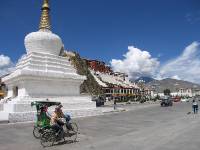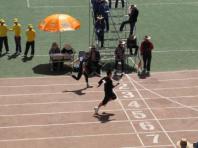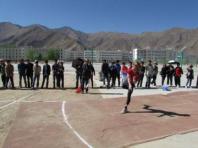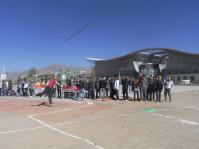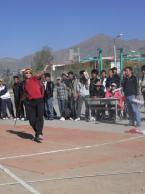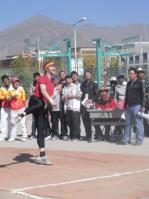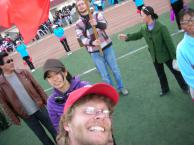Profile
Blog
Photos
Videos
The White and Red Palace
Just before finals we were informed that as part of our Tibetan Culture class we would all be visiting the Potala Palace. The Potala Palace is like Disney's Sleeping Beauty's castle of Lhasa because it over looks the entire city and can be seen from across the city. Supposedly it is difficult to get tickets to especially during high tourist season. Now this is kind of fitting because as I got news of our visit to the Potala I felt very post super bowl victory-like and even exclaimed, "We're going to the Potala!" I don't mean to disrespect the Potala's significance by any means and our trip turned out to be very enriching in terms of local history and culture.
The Potala is architecturally separated for its secular and religious functions. The East side was reserved for government affairs (white side) and the west side for religious matters (red side). The colors of the palace actually are what make up the alternate name for the Potala, as many Tibetans will call it just "the white and red palace."
Interestingly, the Potala even had a school of it's own established by the 13th DL, teaching both secular and religious subjects. The area that housed the former school is located immediately once you enter past the ticket office on the upper level. Unexpectedly and quite strenuously after you make your way up the Potala's steps (least 500 steps and 20 min later) you reach the ticket office. Imagine if you didn't have enough money (100 yuan a ticket) or you forgot something at the bottom and had to go all the way back down. It's a long walk.
The first rooms you enter are religious (no government offices, etc are shown on the tour) for example, we saw the DL's audience rooms, all which have murals or beautiful Buddhist statues (ku in Tibetan). Many are of the Buddha Shakyamuni and protector gods/ deities. You see a few monks here and there, as well as the Potala staff who yell periodically at sightseers for taking photos or forgetting to take off their hats. I really loved the three dimensional mandalas made of gold and silver and talking with a professor who we ran into while he was doing work restoring the wall paintings. He was an expert in thangka art (traditional Tibetan Buddhist painting) and we ran into him as he was mapping the murals next to the 3D mandalas in order to be able to replicate them, as time would require.
Another amazing part of the Potala tour/ visit was all the stupas (tomb like structures which contain relics from past DLs and usually covered elaborately with religious symbols in precious jewels, gold and silver). Just to be standing in front of the final resting places of so many people I had read about in Tibetan history and culture classes was amazing. I was able to witness the tombs of figures that made Tibet what it was and what it is culturally today. I think the rooms of the Great 5th DL's stupa and Padmasambhava's statues were the most breathtaking. Sadly, we moved through the palace at a steady pace and there was just so much I wanted to stop and pause with. I mean there you are standing with Tibetan pilgrims, Chinese tourists, and local Tibetans, seemingly witnessing thousands of years of history all around you.
Our trip to the Potala really embodied the position Lhasa is in today. It's at a crossroads of old and new and of change and tradition. In Lhasa, one can see new department stores selling Armani and Nike and at the same time someone walks by you in the same traditional clothes you see displayed in museums. You see new BMWs and Toyotas and at the same time pilgrims prostrating themselves from the outskirts of Lhasa into it's center market and the Jokhang Temple.
At times I feel like things are changing so fast here with all the construction and infrastructure work I barely recognize street corners I first saw only two months ago. I think by the time I leave Lhasa it will be a totally different city. The locals are used to all the constant change by now but it makes me feel bad for the travel guide companies (someone should tell lonely planet). I don't know how either locals or tour guide-books can keep up. For instance this week, the city discontinued all of its minibus services and now only city buses run. Worst thing is (despite all the jobs lost by the minibus drivers, a heard from a friend they received a settlement and their discontinuation was for traffic reasons) now no one knows where any of the new buses go. None of the new buses kept their old numbers and there are maybe three times as many new buses with new numbers and routes. At every stop you will see Tibetans and Chinese asking where the bus drivers where their bus goes. Now riding the bus is even a bit more chaotic than it used to be. The other day I say three route 22 buses go by me, two with people like sardines and the other completely empty.
Like a Disney theme park there seems to be a lot of area planning going on and I feel lucky to have had the chance to see the Potala. It is so beautiful (especially at night all light up) and the view from the upper level is very telling of how they city has changed over the years and where it is going in the future. Standing up there one just wonders what things looked like so long ago (and not so long ago) and what is in store for the city in the future.
- comments




